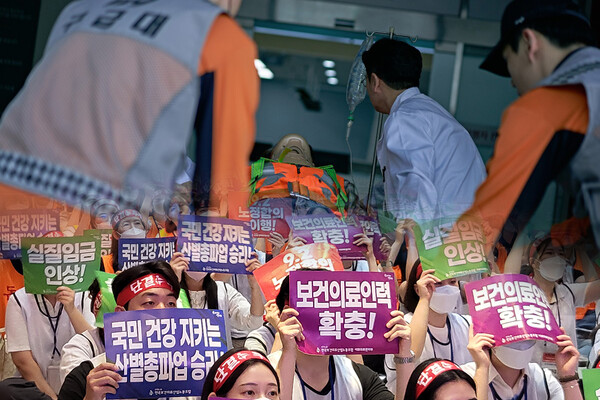
No medical disruptions occurred on Thursday, the first day of a general strike by the Korean Health and Medical Workers’ Union. However, there was chaos as patients rushed to the emergency rooms of hospitals that did not participate in the strike.
Although essential maintenance tasks, such as emergency rooms and intensive care units, were maintained, the operation of inpatient wards was limited due to the massive participation of nurses at university hospitals. As a result, emergency patients are flowing to hospitals nearby the striking medical institutions.
In particular, the participation of tertiary general hospitals and regional base hospitals, such as the national university hospitals, in the strike has jeopardized the response to severe emergency patients.
Some medical professionals predicted that the chaos in emergency rooms would be worse on Friday, the second day of the strike.
The union entered into a general strike at 7 a.m. on Wednesday, with more than 45,000 members participating in 145 workplaces (medical institutions) in 127 branches nationwide. The health workers’ union is affiliated with the Korean Confederation of Trade Unions and has all medical workers, including nurses and medical technicians, as its members.
South Jeolla Province, where training hospitals, such as Chosun University Hospital, Chonnam National University Hospital, and Mokpo Christian Hospital, have all gone on strike, is on the eve of a storm. Local municipal nursing hospitals have joined the strike, causing emergency and nursing home patients to flock to secondary hospitals’ emergency rooms.
“Due to the strike at Chonnam National University Gwangju Geriatric Hospital, we are receiving inquiries from patients there. The bed status board at the Central Emergency Medical Center issued a yesterday, saying that although Mokpo Christian Hospital and Chosun University Hospital were operating emergency rooms, it was difficult to provide follow-up care,” said an emergency medicine specialist at a regional hospital in a phone interview with Korea Biomedical Review. “As a result, there are many emergency patient inquiries at local secondary hospitals."
There is no shortage of beds yet. However, there is a lot of anxiety that if the strike continues to the second day, there may be patients who cannot be handled at secondary hospitals, he said.
“Most of the hospitals participating in the strike are training hospitals, so we don't know where to send them if we cannot handle them. Tertiary hospitals in neighboring areas, including Suncheon, are also on strike. It is very difficult,” he said."
Situations were little different in the Busan area, where Pusan National University Hospital and Pusan National University Yangsan Hospital were on strike. Due to the shortage of nurses in general wards, they have discharged hospitalized patients and reduced outpatient care. Even when patients were admitted to the emergency room, these hospitals were short of personnel and other resources to care for them.
“We evacuated about 70 to 80 percent of the patients, except for severe and emergency patients,” said an official from Pusan National University Yangsan Hospital. “Since many nurses are participating in the strike, there is a large staffing gap to care for patients in the ward after surgery, so we had no choice but to disperse them for fear of medical accidents."
He also said, "The intensive care unit is sufficiently staffed, so it's okay. However, we feel overwhelmed when it comes to admitting patients from the emergency room.”
No major disruptions in Seoul metro region where 'Big 5' hospitals did not join strike
In the Seoul metropolitan region, tertiary general hospitals, including Korea University Anam Hospital, Kyung Hee University Hospital, Ewha Womans University Mokdong Hospital, Hanyang University Hospital, Ajou University Hospital, and Hallym University Sacred Heart Hospital, went on strike. However, no major disruptions were reported because the “Big Five” hospitals did not participate in the strike. The Big Five are Seoul National University Hospital, Samsung Medical Center, Asan Medical Center, Severance Hospital, and the Catholic University of Korea Seoul St. Mary's Hospital.

Hanyang University Hospital is making up for emergency room care, emergency surgery, and outpatient care with the remaining medical staff. However, normal operations are difficult due to the labor shortage. The hospital is not accepting new patients but plans to allow necessary hospitalizations, such as for cancer patients.
Korea University Anam Hospital is operating normally, as a relatively small number of people attended the launching ceremony of the general strike. At the Korea Institute of Radiological & Medical Sciences, it was confirmed that some medical workers took personal leave to participate in the strike and reduced outpatient services, causing little problems.
At Dankook University Hospital, more than 400 nurses are participating in the strike, but the numbers of outpatients, inpatients, and surgeries have not changed much from the previous week. However, the hospital plans to take measures, including adjusting the number of inpatients if the strike is prolonged.
At Kyung Hee University Hospital at Gandong, the number of strikers is estimated to be around 300. The hospital minimizes the void by having non-clinical staff support the medical department to avoid ruptures in treatment schedules.
Related articles
- Concerns mount over paralyzing emergency care amid healthcare workers' strike
- Minister urges health workers ‘not to join umbrella union’s political strike’
- 83% think it ‘necessary to legislate optimal number of patients per nurse’
- Medical workers express fury and discontent upon passage of nursing law

